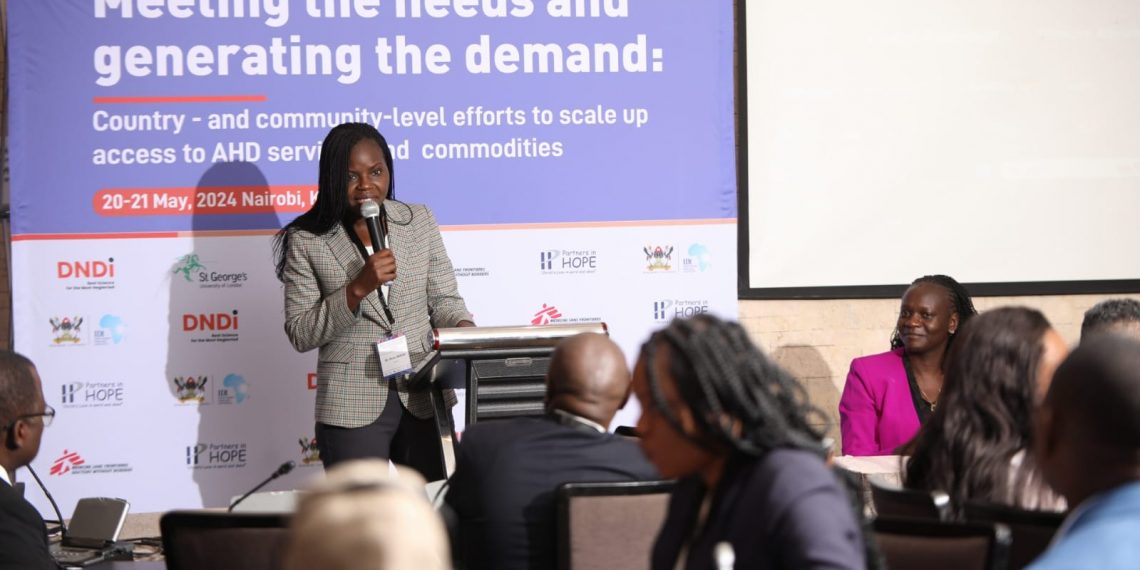Kenya hosted African health experts to address challenges in ending AIDS, determine best ways to effectively and impactfully tackle issues related to diagnosing and treating advanced HIV disease (formerly known as AIDS) and find solutions that will enhance treatment accessibility, facilitate policy changes, and improve the supply chain to end AIDS deaths.
Experts from countries including the Democratic Republic of Congo, Ethiopia, Guinea, Ivory Coast, Sierra Leone, Kenya, Lesotho, Malawi, Mozambique, Nigeria, Tanzania, Uganda, Central Africa Republic, and Zimbabwe participated, along with representatives from WHO, UNAIDS, Unitaid, EGPAF, PEPFAR, AfroCAB, and Global Fund.
The two-day meeting held in Nairobi also brought together representatives from various ministries of health and national HIV programs in Africa, HIV clinicians, researchers, supply chain specialists, civil society and community groups, as well as donors and global stakeholders.
Speaking during the opening ceremony, Kenya’s head of HIV treatment and prevention services, Dr Rose Wafula, said that it is the prerogative of governments to offer leadership and commitment to providing an enabling environment, secure resources, and implement policies towards ending AIDS-related mortalities in Sub-Saharan Africa.
“I am particularly delighted by the presence of government officials and leaders from various countries in sub-Saharan Africa,” Dr Rose Wafula said adding that “Analysis of our own program data shows that up to 1 out 3 persons living with HIV who are either new on treatment, with treatment failure or returning to care after interruption are presenting with AHD.”
Dr Rose added that, “it is therefore our collective responsibility as stakeholders to come together and urgently find solutions and practical ways to prevent, diagnose, treat and follow-up all patients with advanced HIV disease.”
A person with HIV is considered to have advanced HIV disease (AHD) if their CD4 count falls below 200 cells or they show symptoms of HIV clinical stages 3 or 4, according to the WHO classification system. These late stages are usually characterized by tuberculosis, cryptococcal meningitis, and severe bacterial infections. The World Health Organization reports that 630,000 people died of AIDS-related illnesses in 2022.
According to Dr Rose Wafula, Kenya had 18,000 AIDS-related mortalities in 2022, the majority of whom were caused by TB and Cryptococcal meningitis. Despite advancements in access to antiretroviral treatment, hundreds of thousands of people with advanced HIV die each year from Cryptococcal meningitis because affordable and accessible medicines to treat these infections are lacking.
The muti-country meeting, held on the 20th and 21st of May, aimed to provide updates on the latest AHD epidemiological data, clinical guidelines, and scientific advances. African countries also shared country—and community-level progress and programmatic challenges with AHD, creating a space for cross-regional lesson-sharing. They also addressed barriers to access to existing diagnostics and therapeutics and planned for future innovations.
Speaking at the event the Professor Samuel Kariuki, Eastern Africa Director, Drugs for Neglected Diseases initiative (DNDi) reveled that DNDi is working with its partners to reformulate the current flucytosine treatment into a sustained-release formulation. He said that the sustained release formulation will help patients adhere to treatment and simplify healthcare workers’ care.
“At DNDi, we consider advanced HIV disease a neglected disease because there’s very little research and tools to prevent, screen, diagnose, and treat,” said Professor Kariuki adding that “While HIV has received a lot of attention over the years, advanced HIV suffers from limited attention paid to either innovating on existing tools or finding new tools for preventing AIDS-related deaths.”
While, Ajay Rangaraj, the advanced HIV diseases lead at World Health Organization (WHO) revealed during the meeting that an estimated 2 million people are living with HIV in sub-Saharan Africa.
“Men in sub-Saharan Africa are much more likely to have advanced HIV disease than women, despite fewer men having HIV overall,” said Ajay during the session on AHD epidemiological update and overview.
In terms of cryptococcal meningitis, he added that sub-Saharan African countries are leading in cases and deaths, led by South Africa, Kenya, Mozambique, DR Congo, Tanzania, Zambia, Nigeria, Malawi, Zimbabwe and Ethiopia.
The meeting was convened by the AHD alliance, which comprises DNDi, End AIDS Action Group, Fight AIDS Coalition, Infectious Diseases Institute, Makerere University, Uganda, Médecins Sans Frontières (MSF), Partners in Hope, and St. George’s, University of London.
Dr. Medhin Tsehaiu, Kenya’s UNAIDS country director, emphasized opportunities to reduce AIDS-related health disparities. He urged stakeholders to create awareness on ending all forms of discrimination, empowering communities to take the lead in the response, and integrating HIV and other health services, such as screening for non-communicable diseases and mental health.
The meeting also covered topics including community-level progress and challenges, roundtable discussions on the CD4 landscape, advanced HIV disease in children, non-communicable diseases and AHD. It also addressed the latest developments, initiatives, and bottlenecks among key AHD donors, country-level supply chain challenges and solutions, and new tools and technologies in AHD diagnostics and therapeutics.














